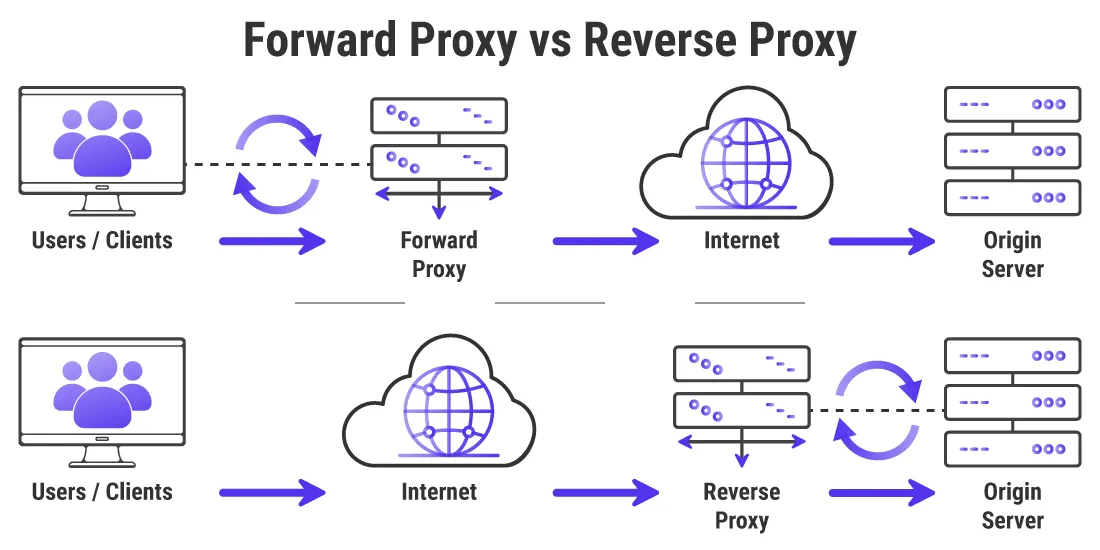· articles · 3 min read
By Jason LForward Proxy vs Reverse Proxy [Differences]
Forward proxies and reverse proxies are both types of proxy servers used in networking and web communication, but they serve different purposes and are configured differently.

As a network architect, I’ve often found myself in the complex realm of proxy servers, grappling with decisions on whether to implement forward proxies or reverse proxies, and how they fit into the larger architecture puzzle. In this blog post, I’ll delve deep into these two types of proxies, their use-cases, comparisons, and the tools that can help you implement them effectively.
Understanding Forward Proxy and Reverse Proxy
Forward Proxy
A forward proxy acts as an intermediary between client devices and the internet. It serves as a gateway for client devices to access resources on the web. When a client makes a request to access a web resource, the forward proxy forwards the request on behalf of the client to the target server. This proxy is especially useful for ensuring anonymity and security for the client.
Use-Cases for Forward Proxy:
- Anonymity: Forward proxies hide the client’s identity by masking their IP address when accessing web resources, enhancing privacy.
- Content Filtering: Organizations can enforce web access policies by inspecting and filtering content requested by clients.
- Caching: Forward proxies can cache frequently requested content, reducing latency and bandwidth usage.
Reverse Proxy
In contrast, a reverse proxy sits between client requests and one or more backend servers, such as web servers or application servers. It receives incoming requests, directs them to the appropriate server, and then sends the server’s response back to the client. Reverse proxies are essential for load balancing, SSL termination, and security.
Use-Cases for Reverse Proxy:
- Load Balancing: Reverse proxies distribute incoming traffic among multiple backend servers to ensure high availability and optimal performance.
- SSL Termination: They handle SSL encryption and decryption, relieving the backend servers from this resource-intensive task.
- Security: Reverse proxies can act as a protective shield, filtering out malicious traffic and ensuring the security of backend servers.
Comparing Forward Proxy and Reverse Proxy
Now, let’s draw a diagram to visualize their placements in a typical architecture:

Scaling and Load-Balancing
When it comes to scaling and load-balancing, forward and reverse proxies have distinct roles:
| Forward Proxy | Reverse Proxy |
|---|---|
| Scaling forward proxies involves deploying multiple proxy servers closer to clients to handle increased traffic. Load-balancing techniques distribute client requests among these proxies. Caching also plays a crucial role in optimizing performance. | Scaling reverse proxies often means deploying them in front of multiple backend servers to distribute incoming requests. Load balancing algorithms, such as round-robin or least connections, ensure even distribution. This setup enhances fault tolerance and scalability. |
Placement and Asset Hiding
The placement of proxies and what assets you want to hide can significantly impact your architecture:
| Forward Proxy | Reverse Proxy |
|---|---|
| Typically placed near the client, forward proxies hide the client’s IP address, making it appear as if requests originate from the proxy server. This is essential for enhancing privacy and bypassing geo-restrictions. | Reverse proxies are usually positioned in front of backend servers. They hide the backend infrastructure from external clients, improving security by concealing server details. |
Making the Right Choice
Ultimately, your choice between forward and reverse proxies depends on your specific use-case and architectural needs. If you need to protect client privacy, enforce content policies, or cache frequently accessed content, a forward proxy is the way to go. On the other hand, if you’re dealing with load balancing, SSL termination, or safeguarding your backend infrastructure, a reverse proxy is your best bet.
Conclusion
In the intricate landscape of network architecture, forward proxies and reverse proxies serve as indispensable tools, each playing a distinct role in shaping communication, optimizing performance, and fortifying security. As network architects, understanding their nuances empowers us to design robust, efficient, and secure networks that meet the demands of modern computing.
References